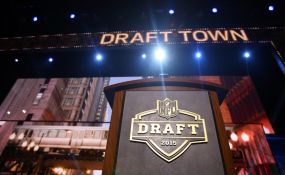
Jason Evans
I am a co-founder and the editor of drinkfive.com. In order to stave off fantasy football insanity, Dave and I have branched out to cover a variety of interests. When I'm not knee deep in wikipedia pages, I like to hang out at breweries or a disc golf course (especially both in the same day). FSWA Member for 5+ years.
I've always been enthralled with the idea of national parks. When I was a little kid, growing up outside Chicago, there was absolutely nothing in my world that compared to the pictures I saw of things like the Grand Canyon and Yellowstone's geysers. I wanted to drive to each and every park on a grand road trip so I could see all the awesome natural areas that this country has to offer. I haven't been able to take such a road trip yet, but on smaller ones, I have managed to make my way to a few parks, and they're all much more spectacular in person.
Listen to the Retrospectical Podcast Episode 11 - America's National Parks

The roots of National parks go all the way back to Lincoln, who granted the lands of the Yosemite Valley and Mariposa Grove back in 1864 to the state of California. It was the first time park land had been set aside specifically for preservation and public use through the US government. Based on this precedent, in 1872 Yellowstone was made into a National Park, basically the first National Park in the world.
Early on, the parks had very few rules regulating them, which caused a lot of conflicts between private businesses, and men who wanted to keep the parks from becoming another Niagara Falls. Niagara Falls, an incredible natural feature, is surrounded by development, and was especially bad back in the 1800's. The people pushing to preserve the parks in the west also wanted to make sure they could remain wild places.
So, why is it important to protect this stuff?
Mesa Verde, the petrified forest and other places were under pressure from people developing the areas or just stealing everything that was there. Yellowstone had people carving their names into rocks everywhere, as if a geyser was nearly perfect, it just required their signature. Yosemite may have gone through the most growing pains. They had squatters, sheep grazing all over the top of the valley, and eventually had an entire valley dammed.
A single organization was needed to take control of all of the parks, and in 1916, through an act of congress, the National Parks Service was created. The parks are really a collection of people who helped preserve them, since nobody gets to claim credit for actually building them.
A few of the most important people early on in the parks:
John Muir - One of the first famous preservationists in America, he helped get the Yosemite Valley, Sequoia and Petrified Forests and many other wild areas preserved. He was known for the spirituality and fervor in which he talked about nature. Muir had a profound effect on the way the country viewed natural areas at the time and is sometimes referred to as the "Father of the National Parks".
So you have an immigrant who grew up to be a great champion for America's wild areas and helped create the idea of National Parks, which then spread around the globe. This idea spread as one of the great cultural gifts that America was able to give back to the world, kind of like Jazz.
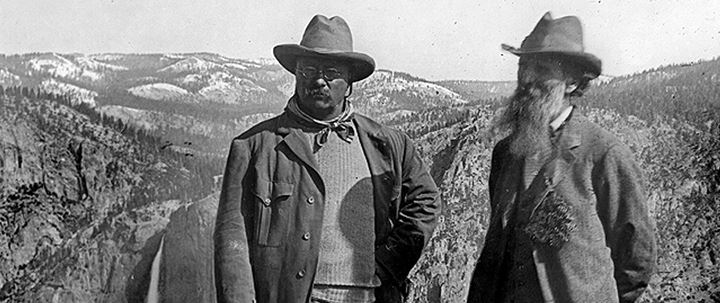 President Theodore Roosevelt and John Muir at Yosemite, 1906.
President Theodore Roosevelt and John Muir at Yosemite, 1906.
Teddy Roosevelt - As president, Roosevelt was a great champion of preserving wild areas. He took a presidential tour of the national parks, and on his visit to Yosemite, spent several days camping alone (after ditching his entourage) with John Muir. Muir's passion fed the President's own for conservation, though they both had different approaches. For example, Roosevelt was an avid hunter, and Muir just couldn't understand that at all, but ultimately they both wanted the same thing.
In 1906, Roosevelt signed the Antiquities Act into law, which gave the president authority, by presidential proclamation (basically the stroke of a pen) to create national monuments from public lands (lands already owned by the government) and set them aside for their natural, cultural and scientific features. This allowed at first for the preservation of specific sites like Devil's Tower in Wyoming and Chaco Canyon in New Mexico, but was then interpreted to preserve most of the Grand Canyon, in Arizona, as well.
Upon his first visit to the Grand Canyon, President Roosevelt remarked: "Leave it as it is, the ages have been at work on it and man can only mar it." A man with a gift for oratory and a passion for wild areas was the best supporter that the early parks system could have hoped for. Roosevelt established 18 national monuments during his presidency.
Buffalo Soldiers - Early on in the parks, there were few laws and fewer people to enforce those laws to protect the land. The US army often served in the parks, and a particular African-American cavalry unit nicknamed the "buffalo soldiers". Serving at several parks in the Sierra Nevadas, they were among the early protectors of the park (and even introduced the distinctive ranger hat - aka the Smokey Bear Hat).
Gifford Pinchot - Pinchot was the first head of the US Forest Service. While he too wanted to preserve forests and other wild areas, he often clashed with Purists like Muir over the use of that land. Pinchot was in favor of using the land for practical uses and profitability. This would help support the lumber industry, but would be managed in a way that continuous cropping would take focus away from short-term gains.
Stephen Mather - Mather was the first director of the National Park Service. He, along with his assistant and successor Horace Albright, shaped the parks system into what it is today. Mather's goal for the parks was to expose it to as much of the public as possible. Through this, he believed that the public support for the parks would be overwhelming and strengthen the entire system they were building.
He expanded the number of parks, helping to determine which places should be chosen for new National Parks and National Monuments. In order to reach the most people possible, he helped create parks in the east and promoted a National Park to Park Highway in the west. Mather allowed cars into the parks for the first time and it really opened the floodgates in terms of tourism.
In 1920, the total visitors passed 1 million for the first time, and in 1925 they topped 2 million. The parks grew fast, which also created lots of congestion. (In 2009, there were nearly 63 million visitors to 59 national parks.)
An interesting story about Mather - He suffered from bipolar disorder which would occasionally cripple him. One of the ways he was able to treat this was to go back out west and spend time in the parks and other wilderness areas. In essence, his expansion of the parks to everyone was his attempt to share what had been so therapeutic and helpful to him.
Mather wanted to build scenic roads in as many parks as he could in order to stress the beautiful parts of the park. Roads were built with the landscape in mind and so as to not become an eyesore. They were placed in ways that the parks could basically be viewed from a car. The result of this were roads like the Going to the Sun Road in Glacier NP.
John D. Rockefeller Jr. - A Philanthropist who took great interest in conservation efforts. He purchased and donated land for Grand Teton, Acadia, Great Smoky Mountains, Yosemite and Shenandoah national parks. He was one of many philanthropists who were important in the creation of the parks.
Some cool features in parks:
Yosemite National Park in California's Sierra Nevada Mountains, features Half Dome Rock, which looks from the valley floor to be a sphere of rock that was cleaved in half, leaving a perfectly vertical face directed into the valley.

Acadia National Park, on the Atlantic coast in Maine, is the oldest park in the east. It was created almost entirely from donated lands organized by people who just wanted to see the island preserved for everyone.
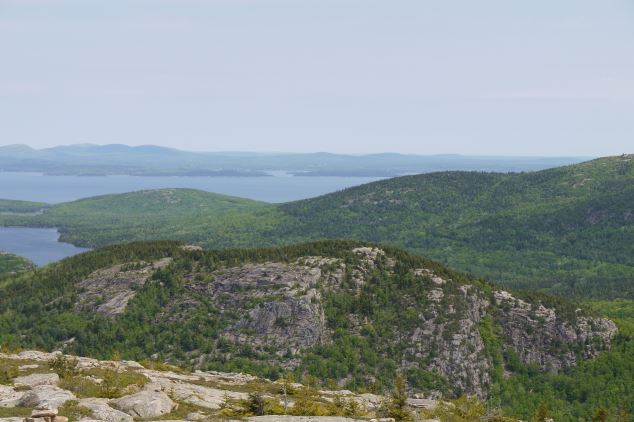
Crater Lake is the deepest lake in the US, over 1900 feet deep, filled entirely by snow and rain, it's remarkably clear and has no inlet or outlet streams.
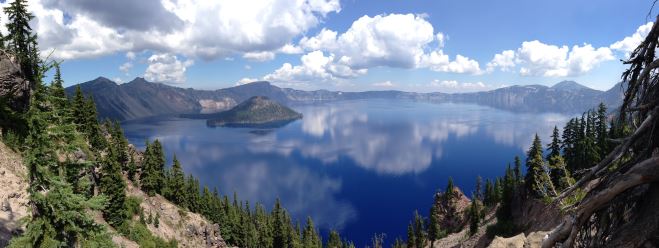
Death Valley is the lowest, driest and hottest place in the US. It's actually quite close to Mt. Whitney, the highest place in the continental US.
The Grand Canyon really is one of the great things in life that lives up to the hype. It's quite a humbling experience to visit, despite the crowds.
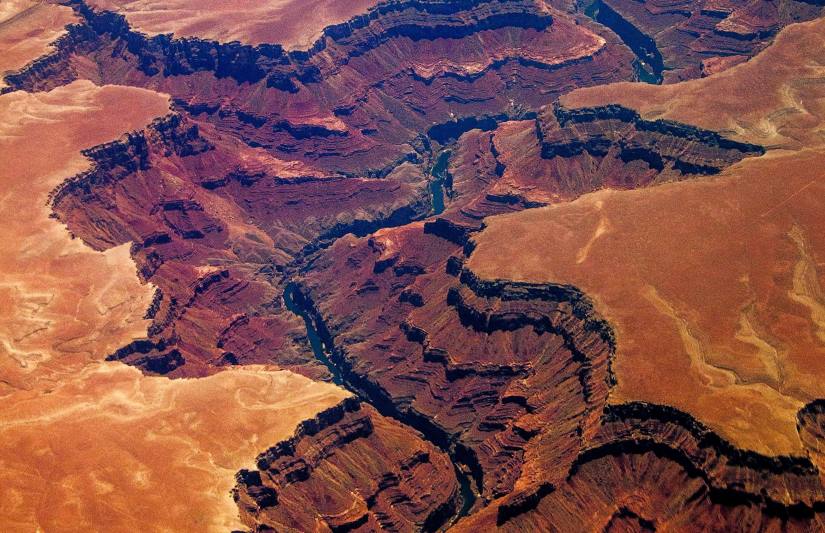
Great Basin National Park has trees called Bristlecone Pines that are over 5000 years old and some of the darkest night skies in America.

Mammoth Cave in Kentucky is the longest cave system in the world, over 400 miles of explored caverns.
Yellowstone is actually on top of a supervolcano, essentially making the entire park a giant caldera and helping to fuel all of the geothermal features throughout the park.
TV Review: Netflix's Daredevil S01E09-10, "Speak of the Devil" and "Nelson v. Murdock"
"Best damn avocados."
Episode 9 - "Speak of the Devil"
Throughout the series, Matt has been dealing with some heavy ethical issues, namely the question of whether it's ok to kill a bad guy or not. When turning this over in his mind, Matt, naturally, goes to church for answers. Father Lantom tells Matt a story about how he came across the Devil, which he had previously dismissed as rather inconsequential until that point. Of course, Matt is searching for a justification to kill Fisk, but even in this conversation, it's not as if he gets a go-ahead. He's left with a rather ambiguous view on the whole thing, though their conversation a little later leaves no wiggle room. It's clear from his actions later on that he decided he would kill Fisk, given the chance.
Listen to the TV Soup Podcast - Daredevil "Speak of the Devil" and "Nelson v. Murdock" Review
This episode, like most in this series, has a good time playing around with the timeline. Instead of traditional flashbacks, you get a beginning, middle, and end of a fight between Daredevil and Nobu (in full ninja garb). I love when a story is able to be told in a non-chronological order, and Daredevil pulls this off with the best of them. It doesn't do it too much of it, like Lost used to do, and it's not strictly a one-way timeline, like Game of Thrones.
As the team at Nelson & Murdock start putting together all the connections in the case (and they are getting somewhere), they get word that Elena Cardenas was mugged and stabbed and died from her wounds. This is the emotional button that Fisk pushed in order to lure the man in the mask into a trap. The trap was excellently executed by Fisk, putting the icing on the cake with his news conference, all but calling out "the mask". This was really a trap for both Nobu and Matt, as Fisk really would have preferred if they killed each other, but he was going to be very happy as long as at least one of them died.
Side note - this show has amazing music placement, especially at the bar. In the background, you hear "The Thrill is Gone" as they're mourning Elena. They lost their friend, they lost their connection to this case. When he leaves the bar, Matt, through the encouraging words of Karen, has made up his mind about killing Fisk. You hear the song ending, and the words are:
You know I'm free, free now baby,
I'm free from your spell
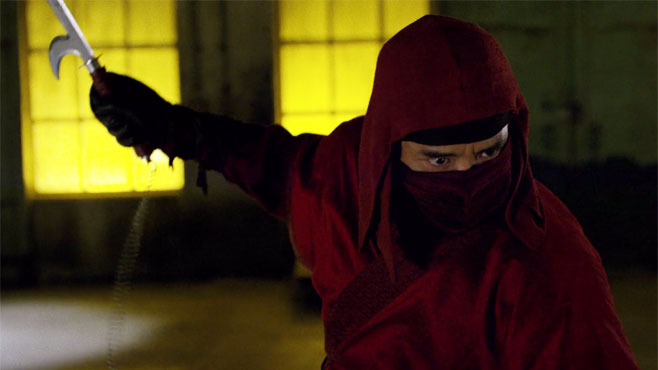
Matt has basically given in to the dark side and decided that he must kill in order to accomplish his goal, and he's even smiling about it.
Matt does seem to get lured into Fisk's traps too easily, but at least it's an excuse to pull him into the best fight all season. This show has a rather high production value, and while I'd like to see a few more sets, it's clear they have spent a lot of money on both the actors and the action sequences.
The fight with Nobu does seem rather one-sided, but of course our hero comes out on top in the end. After that devastating fight with Nobu, when Matt gets his chance against Fisk, it's like trying to fight an elephant and he barely is able to escape alive. I do love the reveal at the end of Foggy learning his secret. In some shows they might have found a cheesy way to get around that, but this definitely complicates the story a whole lot.
Episode 10 - Nelson v. Murdock
So, Matt is unmasked, patched up by Claire, and Foggy wants some answers. The first question of "Are you even blind?" is painful for Foggy, feeling as if he's been betrayed their entire friendship. We then get to see the very beginning of their friendship, complete with music and hairstyles befitting the time period (early 2000's?).
So far, Daredevil has been strong when telling its back story. Getting the entire progression of Matt and Foggy's friendship in one episode is the kind of pacing that would have been good earlier in the season with the stories about Matt's father. You're even given a glimpse into Matt's first taste of masked combat, which, as I suspected, wasn't too long before the start of the story.
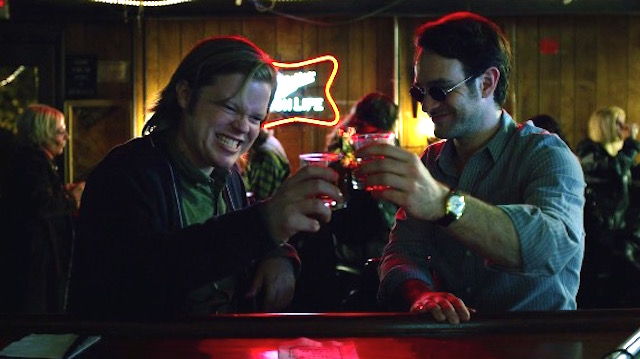
Fisk, trying to be a good citizen, must be a great supporter of rooftop gardens. Seriously, the one he meets Madame Gao in was damn impressive. A small park in a forest of buildings with the sounds of the streets strangely distant. If Fisk wasn't a ruthless murderer, he would be exactly what the city needs. (Well, that's a stretch...)
Foggy's interrogation of Matt channels all of the watcher's questions. When Matt says he just knows things, Foggy demands specifics, and gets them. Weirdly specific, onions two days ago. I wonder how long garlic lingers. Foggy actually sees most of this as an invasion of privacy, which is an interesting angle I hadn't thought about. I'm not sure I see it that way, as Matt is just putting together clues like some supernatural blind Sherlock. It's all there in the open, you just need to know how to perceive it.
Karen, still seemly careless enough to leave her door unlocked (foreshadowing anyone?), manages to locate Fisk's mother. She's in a nursing home, conveniently enough to convince Ben to come along to "check the place out". Of course, what she has to say could be pretty important, but I have to wait until next week to know what that is. You, of course, don't - yay Netflix!
Fisk and Owlsley are getting ready for prom and Fisk has girl problems. Basically - Leland, go deal with the girl who doesn't like my new girl! But with threats thrown back and forth. Everyone seems to be pointing out to Fisk that he's been knocking off members of their group. I suspect this is a one-way ticket to "you're next" land.
This episode with Foggy and Matt seems to turn the whole series up to this point upside down. Everything was built on Matt being the more honest one, the foundation of their partnership in trying to help the little guy. To Foggy, being a vigilante completely violates all of these standards. Foggy sees through the BS and calls Matt out, telling him it's all just an excuse to hit somebody. It will be interesting to see if they're able to fall back on their shared experiences, or if this will be the real end of Nelson and Murdock.
I've been passionate about National Parks ever since I was a little kid. I used to plan grand road trips that would hit as many parks as possible. I wanted to see the biggest, wildest, tallest, grandest features that America's west has to offer. I've made it to a few of them since they were just a trip drawn on a map to me, and on this episode we talk about what it took to create the parks, what's behind them and what our personal experiences with the parks have been.
Retrospectical Podcast Ep11 - America's National Parks
The one thing that I can't stress enough is just how much more amazing all of these places are in person. If you live in America, go visit a National Park. If you don't - go find one near you! There are parks or reserves set aside in almost 100 different countries. Finally, in the words of John Muir, "The mountains are calling and I must go."
Feel that tingling sensation? It's just below your neck, next to your shoulder, you can barely reach it. It's the fantasy football itch! We've been without NFL games for over 3 months, and it's been almost 5 months since there's been any regular fantasy football leagues. It's time to talk fantasy football! This week we're joined by our resident Rookie Expert, Shawn Foss (@Shawn_Foss) and we discussed the brand new 2015 draft class.
Fantasy Football Podcast - May 13 - 2015 NFL Draft Class
Going by position, of course we started at the QB's, just like the NFL teams did. We broke down the possible fantasy impact from two top tier RB's drafted in the first half of the first round, much higher than any RB's have been taken in recent years. Finally, we dug through the incoming WR class. Mostly, we want to know if we'll be as impressed with the rookie WR's as we were last year!
Recent Articles
-
NFL Confidence Pool Picks & Strategy 2024 - Week 18
 To say this has been a year of uncertainty is an understatement. So many injuries, coaching changes, player issues shaped…in Fantasy Football / NFL
To say this has been a year of uncertainty is an understatement. So many injuries, coaching changes, player issues shaped…in Fantasy Football / NFL -
NFL Confidence Pool Picks & Strategy 2024 - Week 17
 Christmas is indeed the time of giving. And this year, the NFL is giving us a double-header on Christmas Day…in Fantasy Football / NFL
Christmas is indeed the time of giving. And this year, the NFL is giving us a double-header on Christmas Day…in Fantasy Football / NFL -
NFL Confidence Pool Picks & Strategy 2024 - Week 16
 Normally, being just a few weeks away from the end of the season, playoff positions are solidified and we need…in Fantasy Football / NFL
Normally, being just a few weeks away from the end of the season, playoff positions are solidified and we need…in Fantasy Football / NFL -
NFL Confidence Pool Picks & Strategy 2024 - Week 15
 Finally! They’re done! We are heading into week 15 and FINALLY we are done with bye weeks! 16 games a…in Fantasy Football / NFL
Finally! They’re done! We are heading into week 15 and FINALLY we are done with bye weeks! 16 games a…in Fantasy Football / NFL
 Please wait...
Please wait...- Home
- drinkfive Podcasts
- Jason Evans



